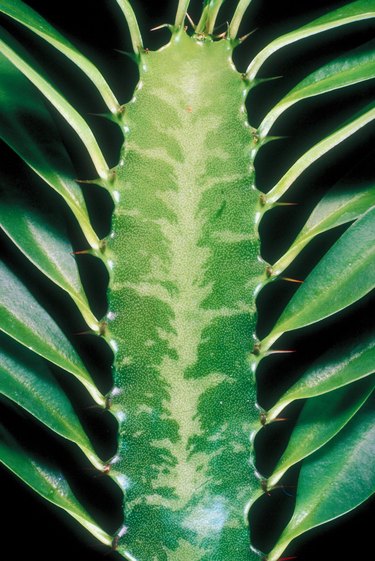Things You'll Need
Container
Water
Sharp knife
Pruning shears
Rubbing alcohol
Waterproof gloves
Safety glasses
Long-sleeved shirt
Newspaper
Kitchen tongs

Not really a cactus but a succulent euphorbia native to southwest Africa, cathedral cactus (Euphorbia trigona) has a number of common names, including good luck plant and African milk tree. It is commonly cultivated worldwide as a container plant or outdoors in U.S. Department of Agriculture plant hardiness zones 10a to 11. Plants grow 6 feet tall. Cultivars include a red-stemmed form (Euphorbia trigona "Rubra") and a crested form (Euphorbia trigona "Crested"). Like other succulent euphorbias, cathedral cactus has poisonous milky sap.
Preparations
Step 1
Find a container deep enough to hold the length of knife blade you'll be using. Fill it with water.
Video of the Day
Step 2
Clean the knife blade and the pruning shears with rubbing alcohol to sterilize them so that you don't introduce plant pathogens as you prune the plant.
Step 3
Put on waterproof gloves, a long-sleeved shirt and safety glasses to protect your skin and eyes from the irritating sap.
Step 4
Cover the work surface with newspapers.
Pruning
Step 1
Use the knife to remove stems on the outside of the plant. Grasp the top of the stem with kitchen tongs. Gently press against the three-angled stem to cut through the outer skin. Take about a 6- to 8-piece section if you intend to root the cutting. Remove the stem back to the main branch if you are pruning to shape the cathedral cactus or to keep it to size.
Step 2
Dip the end of the cutting in water to wash away the sap, and lay it on the newspaper.
Step 3
Wash the knife in the water before taking another cutting.
Step 4
Use pruning shears to remove cuttings that are more toward the center of the plant, where it will be difficult to position the knife for a cut because of closely packed branches.
Cleanup
Step 1
Wash the sap off the pruning tools and the kitchen tongs.
Step 2
Roll up the newspaper so that any drippings of sap are to the inside, and discard it. Discard the water in the container, and wash the container with soap and water.
Step 3
Remove protective clothing and safety glasses. Wash clothing and gloves, and wash off any sap from the outside of the glasses.
Video of the Day